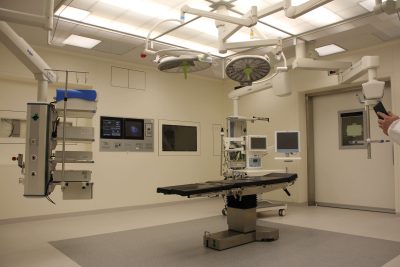What is robotic surgery? All you should know
 Robotic surgery is a type of minimally invasive surgery. Unlike traditional open surgery, robotic surgery uses small incisions to enter the body. This type of surgery is less invasive and has a shorter recovery time. Robotic surgery is made possible by a robot called the da Vinci surgical system. This system consists of a camera and two or three robotic arms. The surgeon controls the robot from a console in the operating room. The da Vinci surgical system is approved for use in a variety of surgeries, including: – general surgery – gynecologic surgery – urologic surgery – cardiovascular surgery – thoracic surgery – pediatric surgery.
Robotic surgery is a type of minimally invasive surgery. Unlike traditional open surgery, robotic surgery uses small incisions to enter the body. This type of surgery is less invasive and has a shorter recovery time. Robotic surgery is made possible by a robot called the da Vinci surgical system. This system consists of a camera and two or three robotic arms. The surgeon controls the robot from a console in the operating room. The da Vinci surgical system is approved for use in a variety of surgeries, including: – general surgery – gynecologic surgery – urologic surgery – cardiovascular surgery – thoracic surgery – pediatric surgery.
What is robotic surgery?
Robotic surgery is a type of minimally invasive surgery. It is performed with the help of a robot, which allows the surgeon to have greater control and precision during the procedure.
Robotic surgery can be used for a variety of different procedures, including those involving the gastrointestinal tract, genitourinary system, and gynecologic system. In some cases, robotic surgery can even be used for open surgical procedures.
One of the benefits of robotic surgery is that it can help to reduce the risk of complications. This is because the surgeon is able to operate with greater precision and control. Additionally, patients who undergo robotic surgery often experience less pain and scarring after the procedure.
The history of robotic surgery
Robotic surgery is a type of minimally invasive surgery. It is also called computer-assisted surgery, robot-assisted surgery, or remote telesurgery. Robotic surgery is a procedure that uses a computer to control surgical instruments. The surgeon sits at a console and views a 3D image of the patient’s body. The surgeon controls the robotic arms with hand and foot pedals.
Robotic surgery was first used in 1985 for neurosurgery. In 1997, the U.S. Food and Drug Administration (FDA) approved the use of robotic technology for general laparoscopic surgery. Laparoscopic surgery is performed through small incisions in the abdomen.
The da Vinci Surgical System is the most common type of robotic surgical system. It was first used in 2000. As of 2011, there were more than 1,700 da Vinci systems installed worldwide.
Robotic surgery has many benefits over traditional open surgery, including:
• Less pain
• Less risk of infection
• Shorter hospital stay
• Faster recovery time
How does robotic surgery work?
There are many benefits to robotic surgery including:
1) Increased accuracy – The robot arm is more precise than a human hand, which leads to fewer complications and a quicker recovery.
2) Reduced blood loss – With traditional surgery, there is often significant blood loss. However, with robotic surgery the surgeon can control bleeding by using cautery or sutures with greater precision.
3) Shorter hospital stay – Because the procedure is less invasive, patients can typically go home the same day or the day after surgery.
4) Reduced pain and scarring – Because the incisions are smaller, there is less pain and scarring associated with robotic surgery.
The benefits of robotic surgery
 Robotic surgery is an effective and minimally invasive surgical option for patients. There are many benefits to robotic surgery, which include:
Robotic surgery is an effective and minimally invasive surgical option for patients. There are many benefits to robotic surgery, which include:
-Shorter hospital stays
-Reduced scarring
-Quicker recovery times
– Reduced risk of infection
– Reduced blood loss
– Reduced pain and discomfort
The risks of robotic surgery
Robotic surgery involves the use of a computer-assisted device to perform surgical procedures. While this type of surgery can offer many potential benefits, there are also some risks associated with it.
One of the main risks of robotic surgery is that it can lead to complications and errors. This is because the surgeon is not physically present in the operating room and is instead relying on a machine to do the work. There have been cases where patients have suffered serious injuries or even death as a result of errors made during robotic surgery.
Another risk is that the use of robots in surgery can increase the cost of treatment. This is because these devices are expensive to purchase and maintain. In addition, hospitals may charge more for surgeries that are performed using robots due to the added costs associated with them.
Finally, there is a risk that patients may not be appropriate candidates for robotic surgery. This is because not all patients will be able to benefit from this type of surgery. For example, those who are obese or have pre-existing medical conditions may not be able to safely undergo robotic surgery.
Despite these risks, robotic surgery can still offer many potential benefits. When performed by experienced surgeons, it can provide patients with shorter hospital stays, less pain, and fewer complications. If you are considering undergoing this type of surgery, be sure to discuss all of the risks and benefits with your doctor beforehand so that you can make an informed decision.
Is robotic surgery right for me?
Robotic surgery is a type of minimally invasive surgery. It is often used for procedures that would traditionally be performed using open surgery, such as heart surgery, prostate surgery, and gynecologic surgery.
Robotic surgery has many benefits over traditional open surgery, including less pain, less blood loss, shorter hospital stays, and faster recovery times. However, it is not right for everyone. You should talk to your doctor about whether robotic surgery is right for you.
Conclusion
Robotic surgery is a minimally invasive surgical procedure that uses a robotic system to control surgical instruments. This type of surgery has many benefits, including less pain and scarring, shorter hospital stays, and faster recovery times. If you are considering having surgery, be sure to ask your doctor if robotic surgery is an option for you.





Comments are closed.